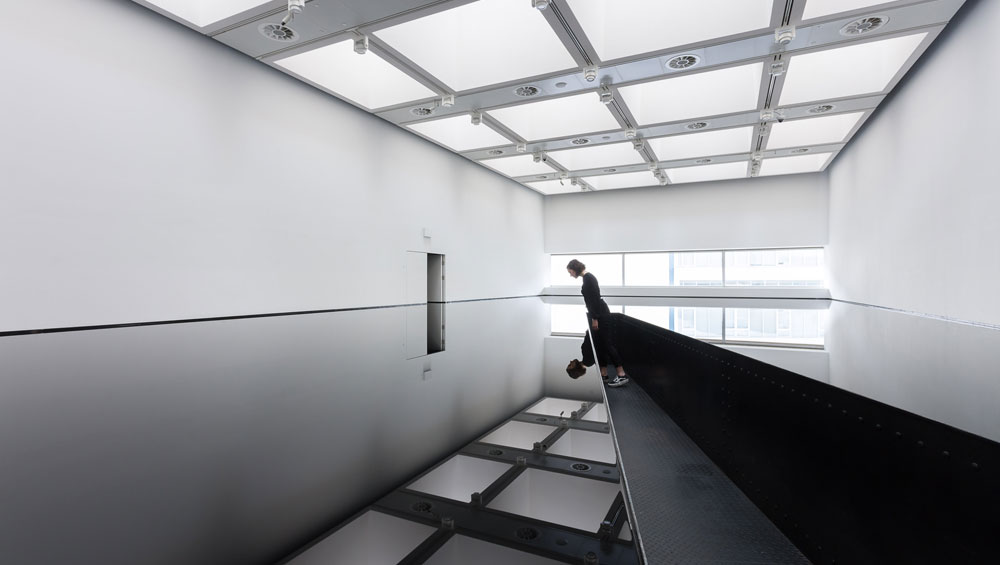
Hayward Gallery, London
26 September 2018 – 6 January 2019
by MATTHEW RUDMAN
Group exhibitions can be disorienting. Combine one or two dozen artists from different generations and cultures in an enclosed space, all riffing on a single theme, and the result is all too often a confusing medley of mixed messages. This makes the Hayward Gallery’s latest offering all the more impressive, offering disorientation of the kind you will be happy to pay for. A thoughtful and quietly playful grouping of works by 20 artists spanning roughly the past half century, Space Shifters transforms the known and familiar, inviting us to question the reliability of our senses with a curious assortment of epoxy obelisks, beaded curtains and giant, rotating mirrors.
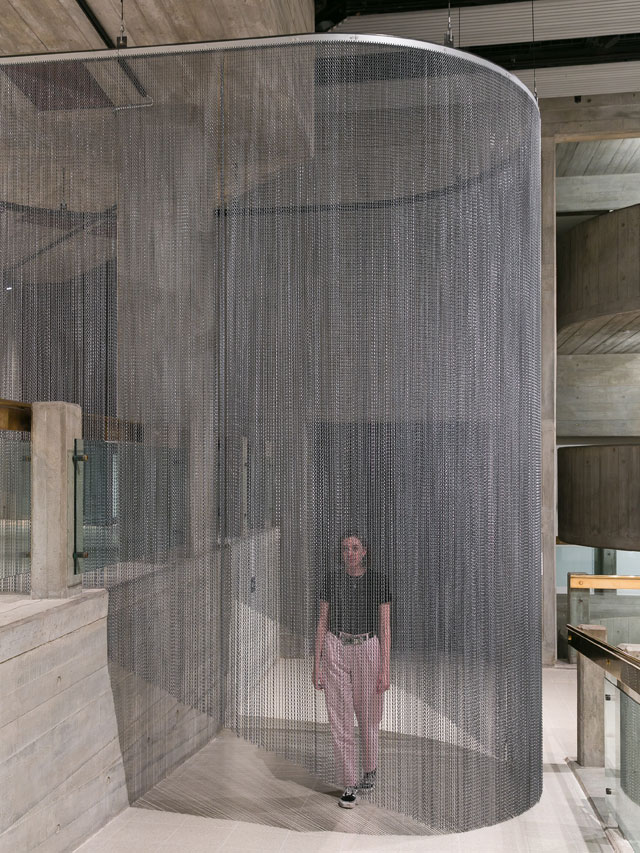
Daniel Steegmann Mangrané, ⊂⊃, 2018. Installation view at Space Shifters © copyright the artist, courtesy Hayward Gallery 2018. Photo: Mark Blower.
It is a fitting conclusion for the Hayward Gallery’s 50th anniversary year, which has seen curators show off the gallery’s renovation with blockbuster exhibitions from Andreas Gursky and Lee Bul. Space Shifters continues the victory lap: site-specific works, such as ⊂⊃ (2018) by Daniel Steegmann Mangrané, respond directly to the gallery’s brutalist architecture, while Richard Wilson’s landmark installation 20:50 (1987) is reprised, filling one of the galleries with impossibly reflective jet-black oil, a gently ascending viewing ramp slicing through the hip-high ooze.
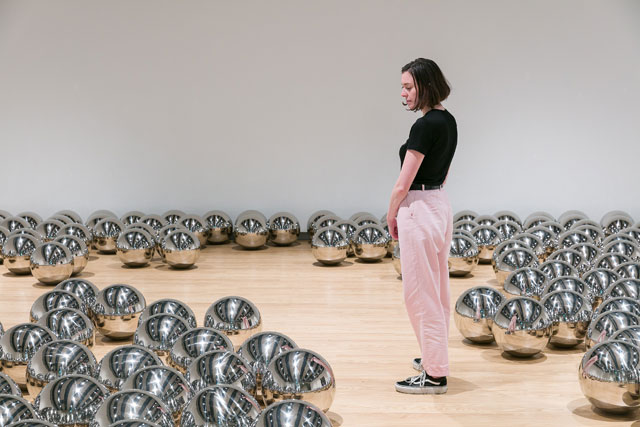
Yayoi Kusama, Narcissus Garden, 1966–. Installation view at Space Shifters © copyright the artist, courtesy Hayward Gallery 2018. Photo: Mark Blower.
Yayoi Kusama’s Narcissus Garden (1966-2018) fills another gallery with a mirage of polished steel orbs, effervescent in the gallery spotlights, and Anish Kapoor contributes two mind-bending sculptures. These big names and set-piece installations are supplemented with a trove of hallucinatory surprises.
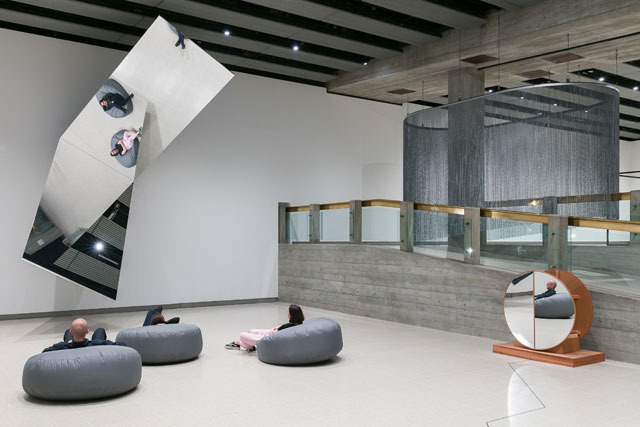
Jeppe Hein, 360° Illusion V, 2018. Installation view at Space Shifters © copyright the artist, courtesy Hayward Gallery 2018. Photo: Mark Blower.
Space Shifters leans heavily on the influence of the light and space movement, a style that emerged from southern California in the late 60s. An offshoot of the decade’s flourishing minimalist art styles, the movement saw artists take up complex technical methods and new materials, such as polyester resin and Plexiglas, borrowed from the engineering and aerospace industries that flourished in and around Los Angeles in the mid-20th century. A 1971 exhibition at UCLA titled Transparency, Reflection, Light, Space helped the style coalesce, showcasing the work of four artists: Peter Alexander, Larry Bell, Robert Irwin and Craig Kauffman. Works from Bell and Irwin are on show at the Hayward, alongside pieces from Helen Pashgian, Fred Eversley, John McCracken and De Wain Valentine, all of whom are loosely associated with the movement.
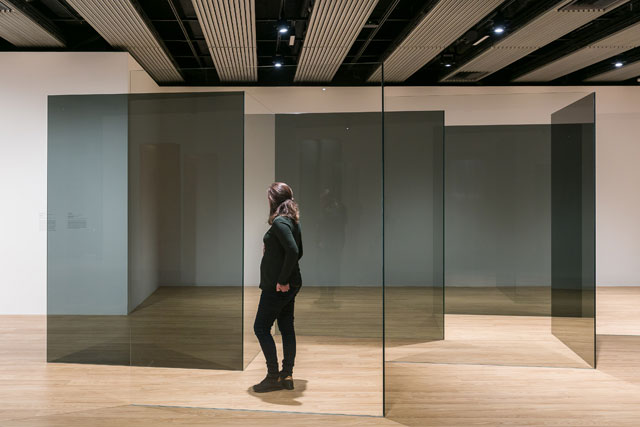
Larry Bell, Standing Walls, 1969_2016. Installation view at Space Shifters © copyright the artist, courtesy Hayward Gallery 2018. Photo: Mark Blower.
Space Shifters is a busy exhibition, but these artworks from the 60s and 70s cut through with their often monumental scale, and establish a cadence that reverberates in the more recent works on display. Irwin’s Untitled (Acrylic Column) (1969-2011) stands at nearly five metres tall: a thin, transparent acrylic prism, the work melts into its surroundings, visible not so much as a discrete object than as a conduit for elegantly fanning rays of light. Nearby is the even more gigantic Gray Column (1975-76) by Valentine, a 1.5 tonne, black cast-resin obelisk, which at first appears to absorb all light, but on approach reveals a fine reflective sheen worthy of a smartphone advertisement.
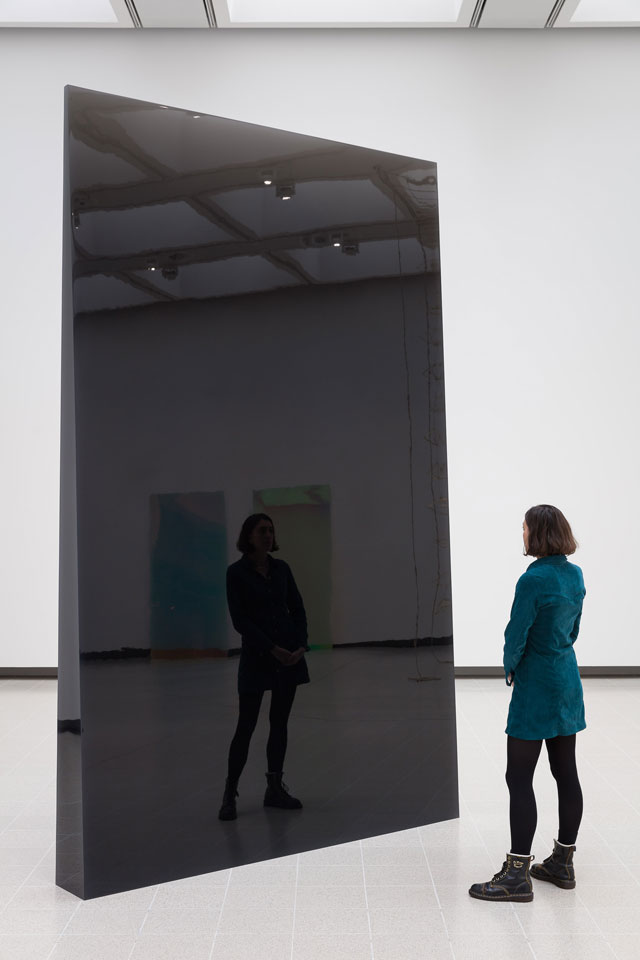
De Wain Valentine, Gray Column, 1975–76. Installation view at Space Shifters © copyright the artist, courtesy Hayward Gallery 2018. Photo: Mark Blower.
Elsewhere, Pashgian’s luminous acrylic columns and coloured epoxy orbs confuse and confound as they warp and refract the light, as if trapped in a liminal state between solid and liquid. Eversley’s Untitled (Parabolic Lens) (1971) is fertile territory for Instagram feeds, inviting pairs to peer at each other through a purple fisheye looking-glass, while Bell’s Standing Walls (1969/2016) sees visitors wander through a miniature maze of filtered light, constructed of alternating clear and grey glass.
,-1971.jpg)
Fred Eversley, Untitled (Parabolic Lens), 1971. Installation view at Space Shifters © copyright the artist, courtesy Hayward Gallery 2018. Photo: Mark Blower.
Also on show are contemporary artists who share the same preoccupations with perception and tricks of the light, and have taken up the mantle of technical experimentation with captivating results. Magic Mirrors (Pink #2 & Blue) (2013-17) by Ann Veronica Janssens lean against a white wall, yet reflect a strange, prismatic and pixellated world back at the viewer, the product of a complex process of multiple layers of glass and dichroic polyester film. One of Roni Horn’s characteristic glass basins is also represented: Untitled (“Everything was sleeping as if the universe were a mistake”) (2012-13) is a cast-glass cylinder that invites the viewer to peek down into illusory depths, a highly polished surface creating the impression of overflowing liquid.
Many of these artworks were born out of the brilliant light and saturated colours of southern California, and it is a strange transplant to see them enclosed within the Hayward Gallery’s austere, windowless concrete walls. One senses that their full potential has not been quite realised in this setting, despite the thoughtful lighting and newly installed skylights, all too often opening out on overcast British afternoons.
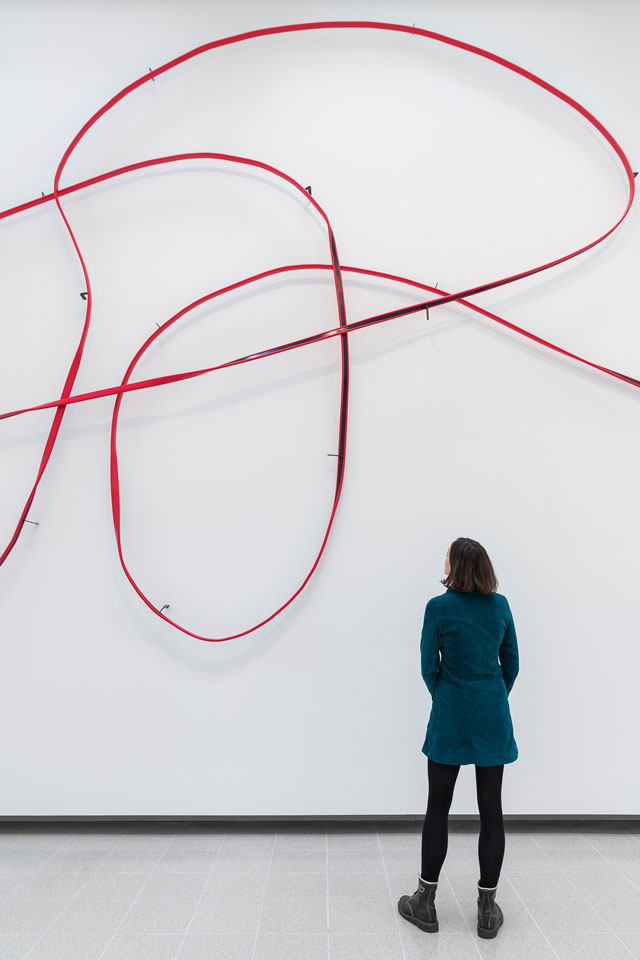
Monika Sosnowska, Handrail, 2016-18. Installation view at Space Shifters © copyright the artist, courtesy Hayward Gallery 2018. Photo: Mark Blower.
Luckily, many more recent works in this collection aren’t so reliant on pristine sunshafts for their effects. Several works have a comic edge: Monika Sosnowska’s exuberant Handrail (2016-18) is installed to wrap around the gallery’s stairwell handrails incognito, before going berserk, looping up the wall in a series of mad swirls. Kapoor’s Non-Object (Door) (2008) is reminiscent of a funhouse mirror, keeping children occupied while confusing adults, who may notice that the reflected wall-text has not been reversed. Josiah McElheny’s Interactive Abstract Bodies (2012) is a smart addition that adds some kinetic flair to the occasionally subdued gallery spaces. Comprised of four sets of wearable mirror boards of different geometric shapes, the sets are worn by trios of dancers as they perform an avant-garde routine across a predetermined path around the room.
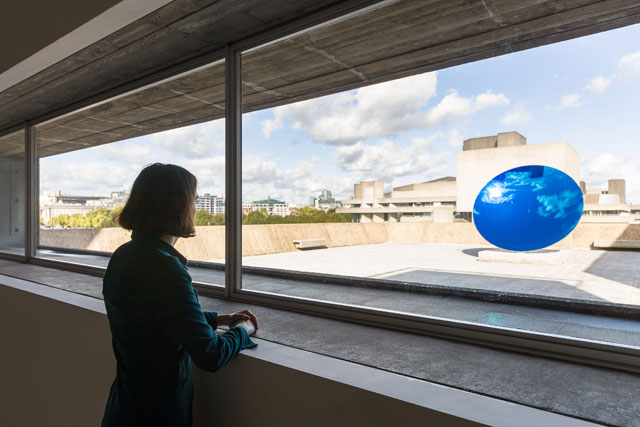
Anish Kapoor, Sky Mirror, Blue, 2016. Installation view at Space Shifters © copyright the artist, courtesy Hayward Gallery 2018. Photo: Mark Blower.
McElheny’s works activate the latent chaotic energy in the surrounding artworks, many of which are made with reflective surfaces, and visitors will often find themselves entranced within a tangled web of reversed and distorted images. Alicja Kwade’s WeltenLinie (2017) is a standout example. Originally developed for the 2017 Venice Biennale, this large-scale installation is a complex lattice of black frames, some empty and some bearing mirrors, with various coloured rocks and petrified tree stumps scattered throughout. What initially appears to be random reveals itself as calculated with impressive precision: through careful arrangement of mirrors, objects appear to change colour with shifts in vantage point, transmuted through some preternatural effect of the light.
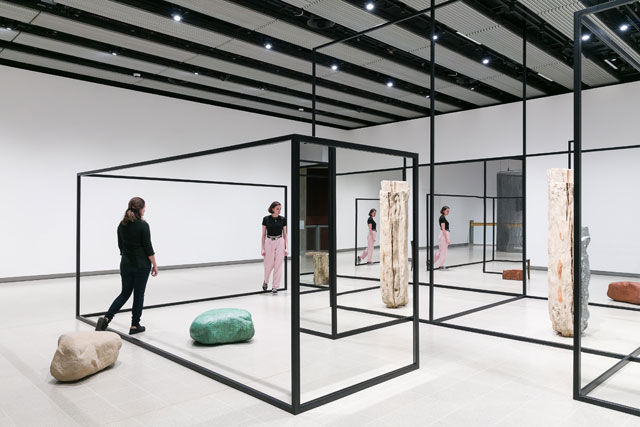
Alicja Kwade, WeltenLinie, 2017. Installation view at Space Shifters © copyright the artist, courtesy Hayward Gallery 2018. Photo: Mark Blower.
The objects on show at Space Shifters appear at first glance innocuous, even boring, and this seems part of the point. The objects themselves are not the main attraction; they are merely catalysts for an interactive experience. What could have been a rather dry, cerebral exhibition is made amusing, engaging and accessible. Visit the Hayward Gallery this autumn and you will find yourself ducking, weaving and dodging your own reflection, gazing through lenses at the distorted and uncanny landscapes that hide in plain sight.